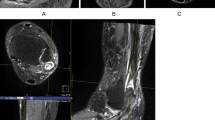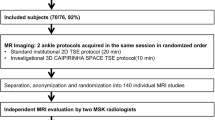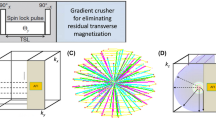Abstract
The objective of this study was to optimize ankle joint MR imaging in volunteers at 1.5 Tesla (T) and 3.0 T, and to compare these optimized sequences concerning image quality and performance in assessing cartilage, ligament and tendon pathology in fresh human cadaver specimens. Initially our clinical ankle protocol consisting of T1-weighted (-w), fat-saturated (fs) T2-w, and short τ inversion-recovery fast spinecho (FSE) sequences was optimized at 1.5 T and 3.0 T by two radiologists. For dedicated cartilage imaging, fs-intermediate (IM)-w FSE, fs spoiled gradient echo, and balanced free-precession steady-state sequences were optimized. Using the optimized sequences, thirteen cadaver ankle joints were imaged. Four radiologists independently assessed these images concerning image quality and pathology. All radiologists consistently rated image quality higher at 3.0 T (all sequences p<0.05). For detecting cartilage pathology, diagnostic performance was significantly higher at 3.0 T (ROC-values up to 0.93 vs. 0.77; p<0.05); the fs-IM FSE sequence showed highest values among the different sequences. Average sensitivity for detecting tendon pathology was 63% at 3.0 T vs. 41% at 1.5 T and was significantly higher at 3.0 T for 2 out of 4 radiologists (p<0.05). Compared to 1.5 T, imaging of the ankle joint at 3.0 T significantly improved image quality and diagnostic performance in assessing cartilage pathology.







Similar content being viewed by others
References
Baumhauer JF, Nawoczenski DA, DiGiovanni BF, Flemister AS (2004) Ankle pain and peroneal tendon pathology. Clin Sports Med 23:21–34
Baker JM, Ouzounian TJ (2000) Complex ankle instability. Foot Ankle Clin 5:887–896
Recht MP, Donley BG (2001) Magnetic resonance imaging of the foot and ankle. J Am Acad Orthop Surg 9:187–199
Kerr R (2002) MRI of soft tissue disorders of the ankle. Clin Podiatr Med Surg 19:285–307
Masala S, Fiori R, Marinetti A, Uccioli L, Giurato L, Simonetti G (2003) Imaging the ankle and foot and using magnetic resonance imaging. Int J Low Extrem Wounds 2:217–232
Moshirfar A, Campbell JT, Khanna AJ, Byank RP, Bluemke DA, Wenz JF Sr (2003) Magnetic resonance imaging of the ankle: techniques and spectrum of disease. J Bone Joint Surg Am 85-A(Suppl 4):7–19
Bencardino JT, Rosenberg ZS (2001) Normal variants and pitfalls in MR imaging of the ankle and foot. Magn Reson Imaging Clin N Am 9:447–463
Lamm BM, Myers DT, Dombek M, Mendicino RW, Catanzariti AR, Saltrick K (2004) Magnetic resonance imaging and surgical correlation of peroneus brevis tears. J Foot Ankle Surg 43:30–36
Pfirrmann CW, Zanetti M, Hodler J (2002) Joint magnetic resonance imaging: normal variants and pitfalls related to sports injury. Radiol Clin North Am 40:167–180
El-Khoury GY, Alliman KJ, Lundberg HJ, Rudert MJ, Brown TD, Saltzman CL (2004) Cartilage thickness in cadaveric ankles: measurement with double-contrast multi-detector row CT arthrography versus MR imaging. Radiology 233:768–773
Ba-Ssalamah A, Schibany N, Puig S, Herneth AM, Noebauer-Huhmann IM, Trattnig S (2002) Imaging articular cartilage defects in the ankle joint with 3D fat-suppressed echo planar imaging: comparison with conventional 3D fat-suppressed gradient echo imaging. J Magn Reson Imaging 16:209–216
Gutberlet M, Schwinge K, Freyhardt P, Spors B, Grothoff M, Denecke T, Ludemann L, Noeske R, Niendorf T, Felix R (2005) Influence of high magnetic field strengths and parallel acquisition strategies on image quality in cardiac 2D CINE magnetic resonance imaging: comparison of 1.5 T vs. 3.0 T. Eur Radiol 15:1586–1597. DOI 10.1007/s00330-005-2768-z
Koops A, Ittrich H, Petri S, Priest A, Stork A, Lockemann U, Adam G, Weber C (2006) Multicontrast-weighted magnetic resonance imaging of atherosclerotic plaques at 3.0 and 1.5 Tesla: ex-vivo comparison with histopathologic correlation. Eur Radiol. DOI 10.1007/s00330-006-0265-7
Bachmann R, Reilmann R, Schwindt W, Kugel H, Heindel W, Kramer S (2006) FLAIR imaging for multiple sclerosis: a comparative MR study at 1.5 and 3.0 Tesla. Eur Radiol 16:915–921. DOI 10.1007/s00330-005-0070-8
Gold GE, Suh B, Sawyer-Glover A, Beaulieu C (2004) Musculoskeletal MRI at 3.0 T: initial clinical experience. AJR Am J Roentgenol 183:1479–1486
Gold GE, Han E, Stainsby J, Wright G, Brittain J, Beaulieu C (2004) Musculoskeletal MRI at 3.0 T: relaxation times and image contrast. AJR Am J Roentgenol 183:343–351
Kornaat PR, Reeder SB, Koo S, Brittain JH, Yu H, Andriacchi TP, Gold GE (2005) MR imaging of articular cartilage at 1.5 T and 3.0 T: comparison of SPGR and SSFP sequences. Osteoarthritis Cartilage 13:338–344
Masi JN, Sell CA, Phan C, Han E, Newitt D, Steinbach L, Majumdar S, Link TM (2005) Cartilage MR imaging at 3.0 versus that at 1.5 T: preliminary results in a porcine model. Radiology 236:140–150
Fischbach F, Bruhn H, Unterhauser F, Ricke J, Wieners G, Felix R, Weiler A, Schroder RJ (2005) Magnetic resonance imaging of hyaline cartilage defects at 1.5 T and 3.0 T: comparison of medium T2-weighted fast spin echo, T1-weighted two-dimensional and three-dimensional gradient echo pulse sequences. Acta Radiol 46:67–73
Hargreaves BA, Gold GE, Beaulieu CF, Vasanawala SS, Nishimura DG, Pauly JM (2003) Comparison of new sequences for high-resolution cartilage imaging. Magn Reson Med 49:700–709
Noyes FR, Stabler CL (1989) A system for grading articular cartilage lesions at arthroscopy. Am J Sports Med 17:505–513
Brandes CB, Smith RW (2000) Characterization of patients with primary peroneus longus tendinopathy: a review of twenty-two cases. Foot Ankle Int 21:462–468
Sitler DF, Amendola A (2001) MR Imaging of the Foot and Ankle: The Orthopedic Surgeon's Perspective. In: Spouge AR, Pope TL (eds) Practical MRI of the Foot and Ankle. CRC Press, Boca Raton London New York Washington DC, pp 271–296
Hanley JA, McNeil BJ (1982) The meaning and use of the area under a receiver operating characteristic (ROC) curve. Radiology 143:29–36
Vasanawala SS, Hargreaves BA, Pauly JM, Nishimura DG, Beaulieu CF, Gold GE (2005) Rapid musculoskeletal MRI with phase-sensitive steady-state free precession: comparison with routine knee MRI. AJR Am J Roentgenol 184:1450–1455
Schmitt F, Grosu D, Mohr C, Purdy D, Salem K, Scott KT, Stoeckel B (2004) [3 Tesla MRI: successful results with higher field strengths]. Radiologe 44:31–47
Schibany N, Ba-Ssalamah A, Marlovits S, Mlynarik V, Nobauer-Huhmann IM, Striessnig G, Shodjai-Baghini M, Heinze G, Trattnig S (2005) Impact of high field (3.0 T) magnetic resonance imaging on diagnosis of osteochondral defects in the ankle joint. Eur J Radiol 55:283–288
Collins CM, Smith MB (2001) Signal-to-noise ratio and absorbed power as functions of main magnetic field strength, and definition of “90 degrees ” RF pulse for the head in the birdcage coil. Magn Reson Med 45:684–691
Recht M, Bobic V, Burstein D, Disler D, Gold G, Gray M, Kramer J, Lang P, McCauley T, Winalski C (2001) Magnetic resonance imaging of articular cartilage. Clin Orthop Relat Res:S379–S396
Tan TC, Wilcox DM, Frank L, Shih C, Trudell DJ, Sartoris DJ, Resnick D (1996) MR imaging of articular cartilage in the ankle: comparison of available imaging sequences and methods of measurement in cadavers. Skeletal Radiol 25:749–755
Sobel M, Bohne WH, Markisz JA (1991) Cadaver correlation of peroneal tendon changes with magnetic resonance imaging. Foot Ankle 11:384–388
Author information
Authors and Affiliations
Corresponding author
Additional information
Cameron Barr and Jan S. Bauer both equally contributed to this work.
Rights and permissions
About this article
Cite this article
Barr, C., Bauer, J.S., Malfair, D. et al. MR imaging of the ankle at 3 Tesla and 1.5 Tesla: protocol optimization and application to cartilage, ligament and tendon pathology in cadaver specimens. Eur Radiol 17, 1518–1528 (2007). https://doi.org/10.1007/s00330-006-0446-4
Received:
Revised:
Accepted:
Published:
Issue Date:
DOI: https://doi.org/10.1007/s00330-006-0446-4




